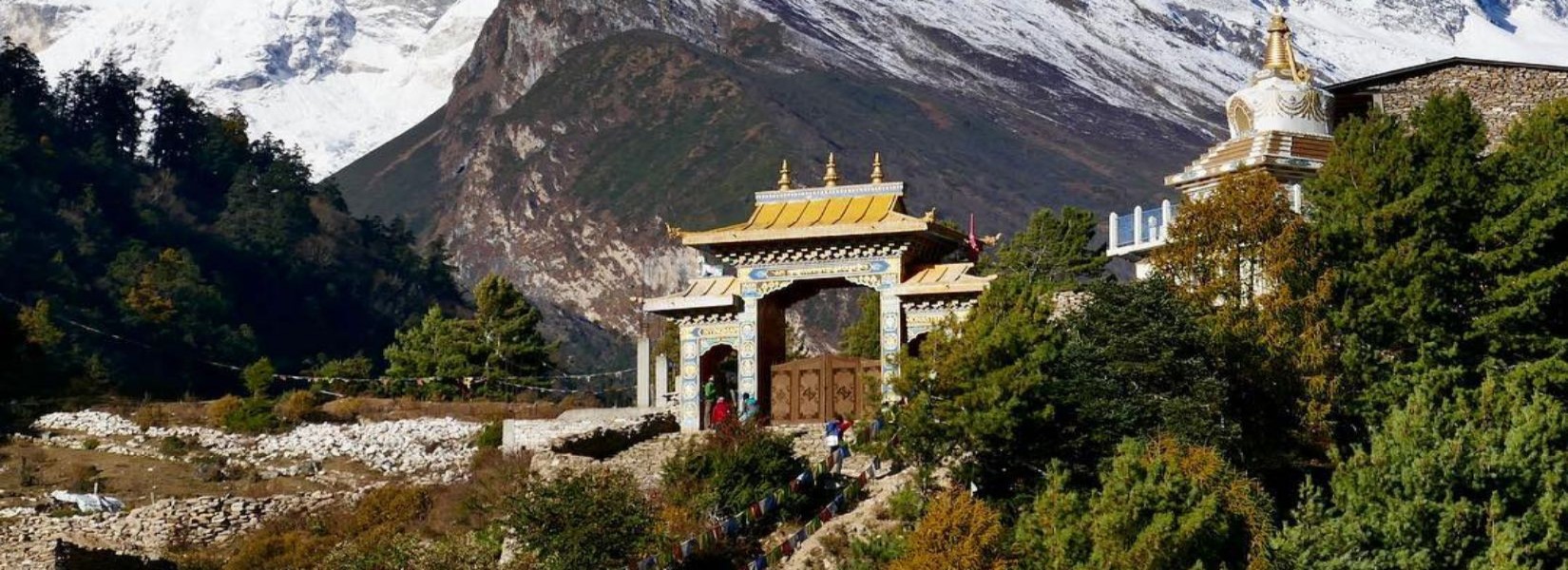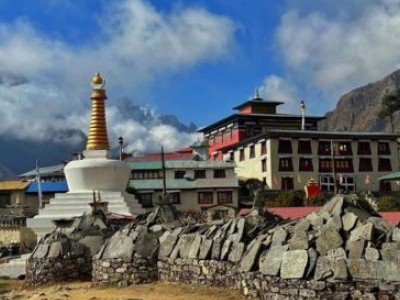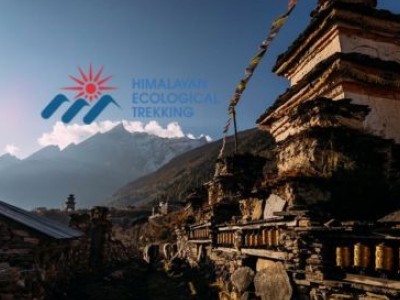Introduction to the Monasteries of the Manaslu Region
Spiritual Importance and Tibetan Buddhist Culture
The monasteries in the Manaslu region are centers of Tibetan Buddhism, not just structures. These places encompass living faith and spiritual practices by monks and nuns daily. Close to Tibet, this region has retained aspects of Tibetan culture, which is unique to every place the clashing Cultures combine.
The indigenous Nubri and Tsum people practice Buddhism in addition to Animism. They work each day by their belief, and the monasteries are vital to controlling that belief system.
A Brief History of Sacred Heritage in the Manaslu Region
The Manaslu region contains very diverse socio-cultural landscapes. The upper areas are predominantly home to Tibeto-Burman communities, whereas the lower hills are home to Indo-Aryan communities who practice Hinduism. This creates interesting links and intersections of religions throughout the trekking routes.
Spectacular stone houses with unique architecture, prayer flags, and ancient monasteries litter the landscape.Villages like Lho, Samagaun, and Samdo showcase beautiful Tibetan-influenced buildings that have stood for centuries.
4. Journey Through Faith: Top Monasteries to Visit in the Manaslu Region
These top monasteries to visit in the Manaslu region are deeply rooted in tradition and spirituality. Each Manaslu ancient monastery provides a unique perspective on monastic life. Here are some of the Top Monasteries to Visit in the Manaslu Region:
| Monastery Name | Location (Village/Valley) | Altitude (approx.) | Key Feature/Significance | Accessibility Note |
| Mu Gompa | Tsum Valley, near Mu Village | 3700m (12,139 ft) | Oldest, largest, most isolated; Nyingma school; stunning views; prayer wheels & mani walls | 2-3 day hike from Chumling; can extend to Tibet-Nepal border |
| Rachen Gompa | Tsum Valley | 3240m | Largest nunnery (200-300 nuns); oldest (1905 AD); nuns study secular subjects | 2-3 hours from Chhekampar via Tsum Valley Trek trail |
| Pungyen Gompa (Shyala Monastery) | Near Samagaon, base of Manaslu Himal | 4000m (13,123 ft) | Most significant on Manaslu Circuit; meditation retreat; ancient Buddhist relics | Side trip for acclimatization before Manaslu Base Camp/Larke Pass |
| Serang (Nubri/Shringi) Gompa | Kyimolung Valley, below Shringi Himal | Not specified | Unique, remote; over 100 monks/nuns; "valley of peace and happiness" | Side trip during Tsum Valley trek |
| Gumba Lungdang | Nubri Valley, Gorkha district | 3200m (10,499 ft) | Revered nunnery; established centuries ago; special festival in September | Route coincides with Tsum Valley Trek; from Dumje after suspension bridge |
| Ribung Gompa | Not specified | Not specified | Notable monastery in the region | Mentioned as a significant site |
| Kal Chhokang Gompa | Not specified | Not specified | Notable monastery in the region | Mentioned as a significant site |
| Lho Monastery | Lho Village, Manaslu Circuit Trek | Not specified | Important site on the Manaslu Circuit Trek | Located in Lho Village |
Sacred Gumba Lungdang (Nubri Valley)
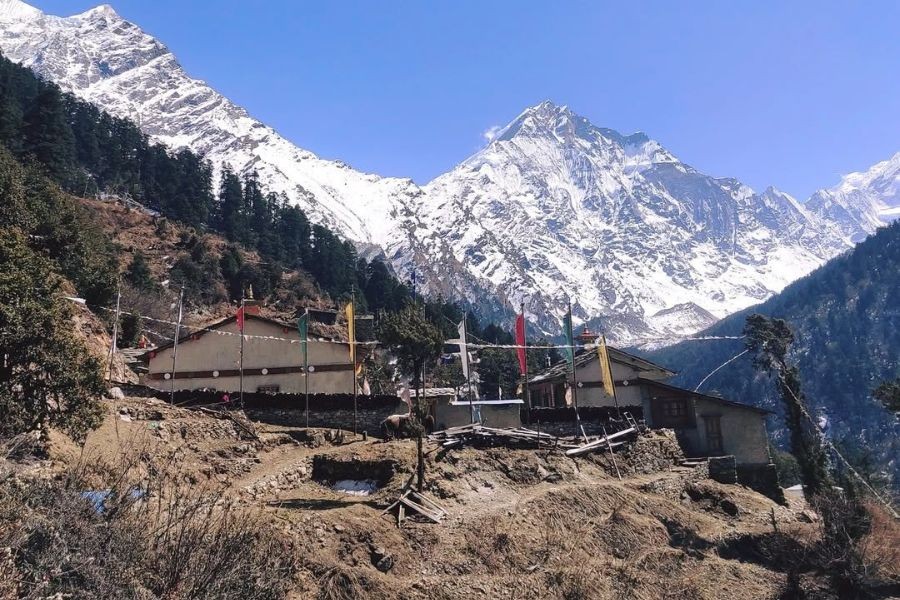
Gumba Lungdang is located at 3,200 meters in the Nubri Valley of Gorkha district. This revered nunnery serves exclusively as a home for nuns. A Tibetan Buddhist monk established it centuries ago, and it continues to attract visitors from around the world.
The nunnery holds a special festival in September that draws local communities together. Young girls often enter this monastery at an early age to seek knowledge and spiritual enlightenment. The route to Gumba Lungdang connects with both the Tsum Valley Trek and the Manaslu Tsum Valley Trek.
Pungyen Gompa (Shyala Monastery) near Samagaon
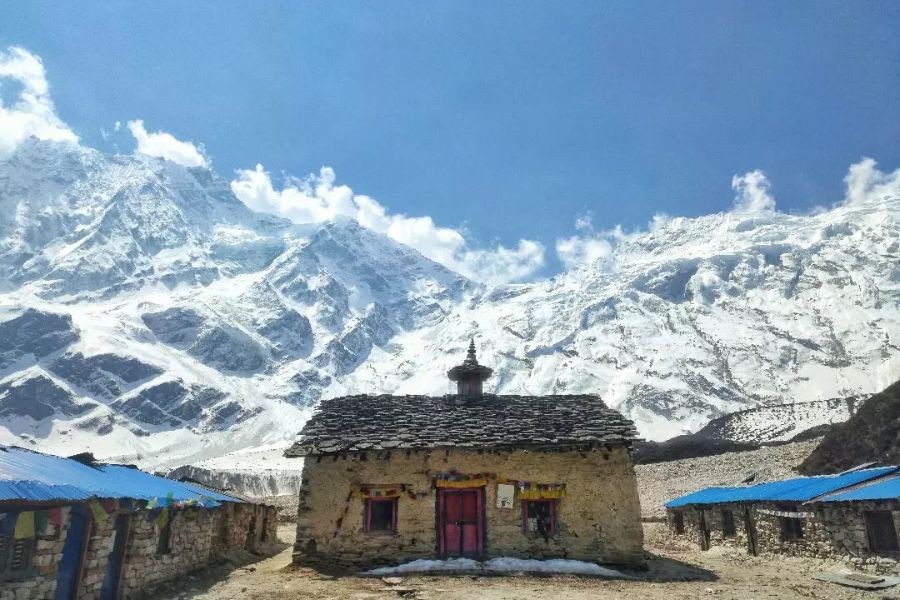
Pungyen Gompa is located above Samagaon at 4,000 meters or above, making it the most important monastery on the Manaslu Circuit Trek route. The monastery is located at the base of Manaslu Himal and is a significant meditation retreat site. The monastery houses extremely ancient Buddhist texts, thangkas, and relics. Monks perform regular Buddhist teachings, meditation, and rituals at the monastery. As the monastery is located above the other villages, many trekkers will visit Pungyen Gompa as an acclimatization side trip before the strenuous trek to Manaslu Base Camp or Larke Pass.
Mu Gompa: The Most Isolated Monastery
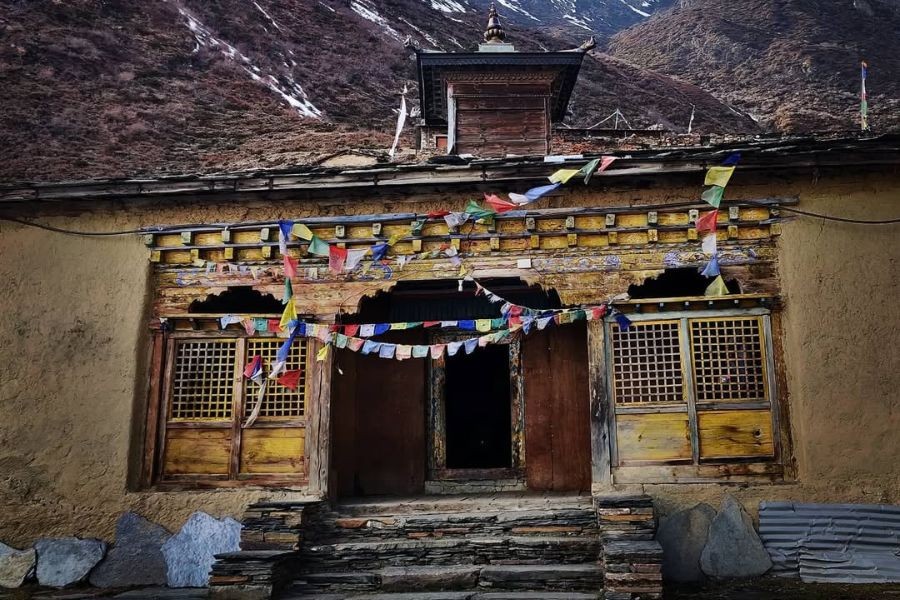
Mu Gompa is perhaps the most iconic monastery in Nepal, located in the isolated Tsum Valley monasteries cluster. Mu Gompa represents one of the oldest, largest, and most isolated monasteries in the Manaslu region. This monastery sits in the remote Tsum Valley at an altitude of 3,700 meters. It was formally established in the 17th century and falls under the Nyingma school of Buddhism.
The monastery has fantastic views of the soaring Himalayan ranges that rise above it. There are equally impressive prayer wheels and mani walls that wrap around the building, giving a sense of calm. The monks of Mu Gompa devote their lives to chanting, meditation, and studying Buddhist scriptures.
The journey to Mu Gompa is a 2-3 day hike from Chumling, where you pass through Chhekampar and Nile Villages. For those with adventurous spirits, you can hike a little further to get closer to the Tibet-Nepal border.
Rachen Gompa: The Nunnery of Devotion
Rachen Gompa is unique from the other monasteries in the Tsum Valley for its educational aspect and large nunneries. It is located at 3,240 meters and was established around 1905 AD by Guru Rimpoche, giving residences and education to approximately 200-300 nuns.
The most intriguing part of Rachen Gompa is that the nuns study "regular" subjects like English, Nepali, and Science, alongside their regular offerings in Tibetan Buddhist teachings. This, in turn, allows the nuns to engage with the modern world while maintaining their spiritual living.
The monastery holds special significance in the Tsum Valley's "non-sacrificing place" tradition. Historical breaches of non-violence laws were symbolically atoned for by lighting 1,000 candles within its premises. You can reach Rachen Gompa via a 2-3 hour hike from Chhekampar along the Tsum Valley Trek trail.
Ribung Monastery in Lho Village
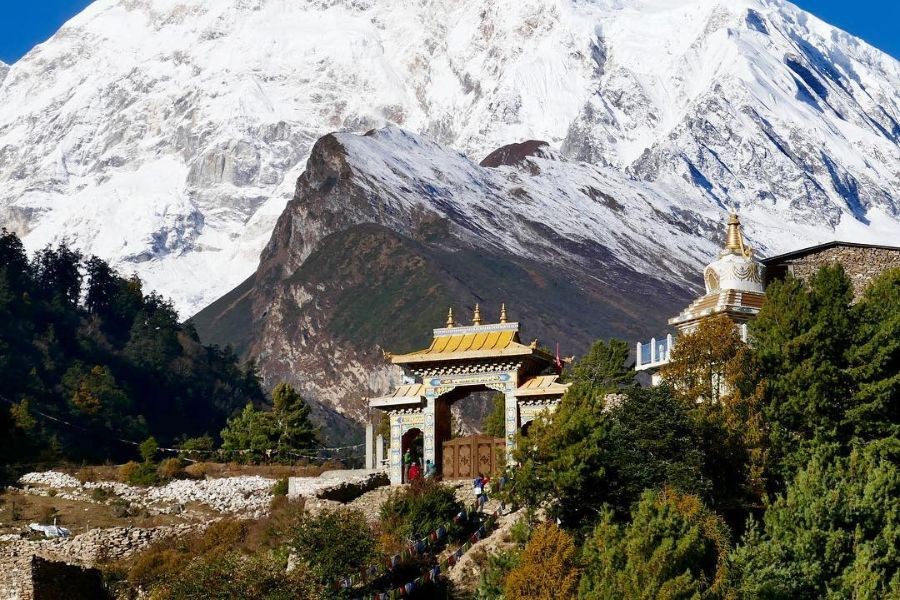
Ribung Monastery is an important spiritual center for Lho Village along the Manaslu Circuit Trek. It is an important place for the local people in their daily lives, and it allows visitors to see real, authentic Buddhist practices.
Serang (Nubri) Monastery
Serang Gompa, also known as Nubri Monastery or Shringi Gompa, is located in the Kyimolung Valley, below the Shringi Himal. This unique and remote monastery is home to in excess of 100 monks and nuns, and is in what the locals refer to as the "valley of peace and happiness."
The monastery holds such spiritual significance that the name Shringi Himal is derived from it. Visitors can enjoy panoramic views of Shringi Himal and explore this monastery as a side trip during the Tsum Valley trek.
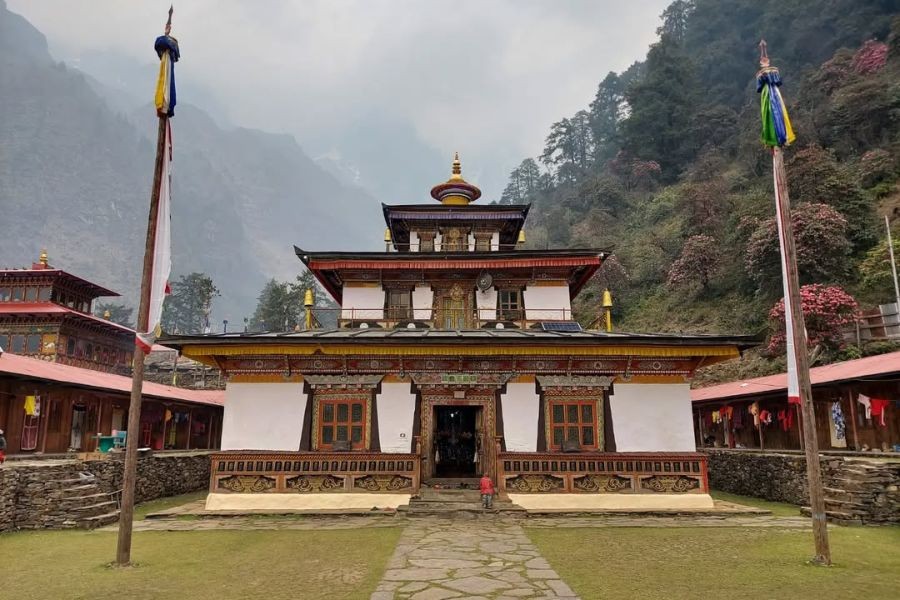
Shringi Gompa in Bihi
Shringi Gompa represents another important spiritual site in the region. This monastery contributes to the rich spiritual landscape of Manaslu and offers visitors authentic Buddhist experiences.
Cultural and Spiritual Experiences at the Monasteries
Daily Rituals, Prayers, and Meditation Sessions
The daily rituals in the Buddhist gompas of Nepal, especially in the best monasteries in the Manaslu region, continue to attract spiritual trekkers seeking authentic Himalayan experiences. They spend long hours in meditation and chanting mantras. Their days focus on studying Buddhist scriptures and philosophy, all aimed at achieving inner peace and spiritual growth.
Local people frequently visit these monasteries for religious ceremonies. They seek blessings and advice from the resident monastics. This close connection between the monastic community and local people shows how these monasteries serve as living centers of faith and tradition.
Festivals: Lhosar, Mani Rimdu, Dumje, Saga Dawa
The Manaslu region celebrates several important festivals throughout the year. Lhosar, the New Year celebration, brings great enthusiasm to various ethnic groups, including the Tamang, Gurung, and Sherpa communities.
In January or February, the Tamang people will typically celebrate Sonam Lhosar with their traditional Selo dances, Damphu music, and visits to monasteries for prayers. The Gurungs' celebration is Tamu Losar, celebrated in January with family gatherings and traditional foods. For the Sherpas, the holiday is Gyalpo Lhosar, which is celebrated during February or March with special feasts and cultural events.
The Tsum Shagya Centennial Festival holds unique historical significance in the Tsum Valley. This festival commemorates a nonviolent tradition started in 1920, where locals vowed to preserve their land as a "non-sacrificing place." The Mani Rimdu festival adds to the cultural calendar with live dance performances and prayer recitations.
Interaction with Monks and Nuns
Visitors to the Monasteries of Manaslu can interact with monks and nuns and observe their daily lives and spiritual practice. These moments allow one to appreciate Tibetan Buddhist philosophy and meditation practices profoundly.
Many monastics' English is rudimentary, but they usually seem very keen to explain and share with respectful visitors. Through these direct dialogues, the exchange can sometimes lead to deep discussions on Buddhist philosophy and the challenges of monastic life in the remote mountain areas.
How to Reach and Visit the Monasteries
The Trekking Routes and road access points (Tsum Valley Trek, Manaslu Circuit trek)
Most of the monastery stops in the region of Manaslu are connected with the Manaslu Circuit Trek or the Tsum Valley Trek. These are two of the more popular trekking routes that encompass an ideal blend of physical adventure and spiritual discovery.
The Manaslu region is a restricted zone, so all visitors need special permits and must travel with a government-licensed guide. The Nepalese government created these regulations to protect the region's unique natural environment and cultural heritage.
Recent road construction has changed trek distances and starting points. Jeep access has now reached Jagat and Deng villages in the early segment, as well as Tilje village, which is approximately 13 kilometers from Bimthang. This can reduce the number of trekking days on some segments.
Best Times to Visit (Spring and Autumn)
Spring (March-May) and autumn (September-November) are the best seasons to visit Manaslu's monasteries because the weather is stable, the skies are clear, and the temperatures are suitable for high-altitude trekking and cultural exploration.
In spring, vegetation gets lush with blooming rhododendrons and can provide clear mountain views, while autumn offers pristine air and excellent visibility of the peaks that surround Manaslu. Both provide opportunities for stunning photography and spiritual contemplation.
Accommodation and Visitor Suggestions
Accommodation along the Manaslu Circuit mainly includes teahouses. Some nunneries, such as the Gumba Lungdang, may have the option for visitors to spend the night with very limited basic facilities, usually for a small fee. The teahouses and nunneries will provide a simple, clean room and basic meals.
To respect the monks and the culture as a whole, ensure to dress somewhat modestly and ask permission to take pictures, especially of people or of ceremonies. Remain silent or whisper when rituals or meditation are being performed. If you choose to take photos in a monastery, remain aware of your surroundings and other visitors who may be trying to meditate or contemplate.
Monasteries also appreciate a small donation to help toward maintenance and to help the monastic community as a whole.
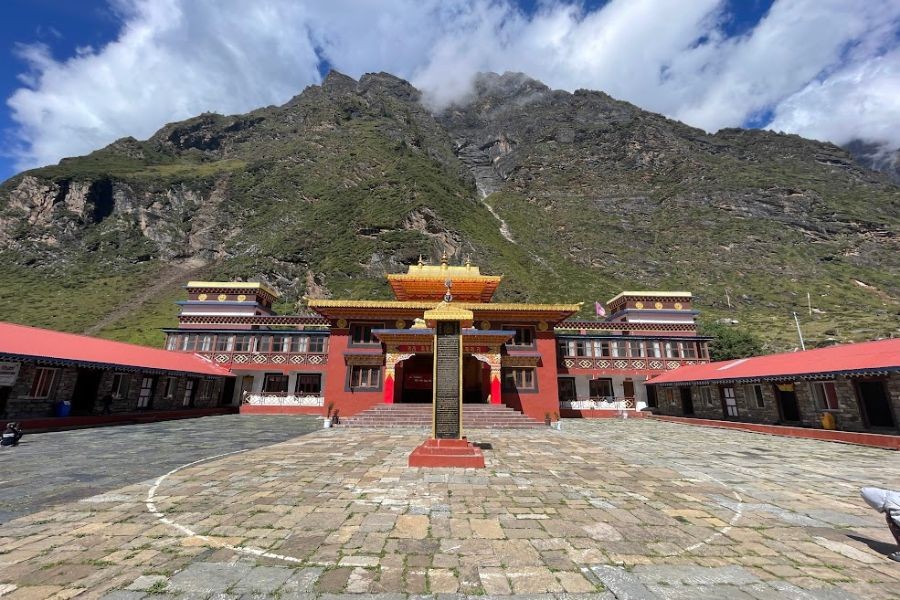
The Role of Monasteries in Local Life and Tibetan Buddhism
Education and Community Life in Monasteries
Monasteries situated in the Manaslu region provide important educational services. They teach young people not only Buddhist philosophy but also marketable skills needed for life in the mountains in preparation for a future independent of foreign sponsorship. Some of these monasteries, like Rachen Gompa, even teach modern and mainstream subjects in addition to traditional Buddhist studies.
The monasteries also serve as community centers where local people gather for festivals, celebrations, and important life events. In the tougher moments of life, they serve as a source of guidance, and, on a deeper level, they house knowledge and local traditions.
Preservation of Tibetan Buddhist Traditions
These monasteries are important in preserving Tibetan Buddhist traditions, which may otherwise be lost. Ancient texts, art, and ritual practices have been preserved and passed down from generation.
The monastic community works diligently to document and preserve traditional knowledge while also addressing modern realities and challenges together. This delicate balance of supporting traditional practices simultaneously with evolving and modernity provides a growing advantage for these distinct cultural and traditional practices to continue surviving into the 21st century.
Planning Your Spiritual Trek in the Manaslu Region
Preparation and Permits
You need to consider planning out your trip to the Manaslu monasteries beforehand. You will require several permits for the trek. For example, you need a Manaslu Restricted Area Permit, a Manaslu Conservation Area Permit, and an Annapurna Conservation Area Permit.
You must have licensed guides, and you can only travel in groups of two or more. This is meant to provide safety and local jobs for their tourism economy.
You will need to prepare physically for the high altitudes lest the terrain and altitude. I would suggest doing physical training for several months leading up to the trip, including hiking, cardio, or any activity that can acclimate your body to higher altitudes.
Combining Trekking with Spiritual Exploration
The ideal way of visiting Manaslu monasteries presents a fusion of a physically wandering journey with a spiritual journey. Your itinerary is better if you plan to spend the rest days at the monasteries you would like to visit that offer opportunities for participation to engage in meditation sessions as well as learn fundamentals of Buddhism.
If the monastic communities offer to include you in morning prayers or evening chanting, you may as well join, and this can be a great experience to have a deeper understanding of the spiritual life of these mountain communities.
You are going to need to pack accordingly to trek to these monasteries and visit. I recommend that you pack warm, modest clothing that covers your arms and legs. A small headlamp may prove useful as part of your pack to attend early morning prayer sessions. You might also want to keep a journal to reflect on your spiritual experiences.
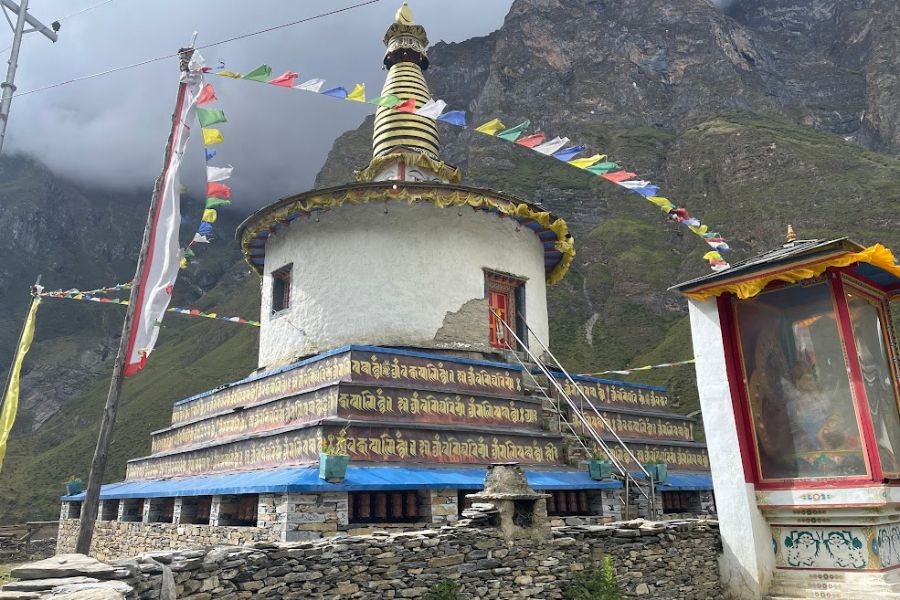
FAQs
Do I require special permits to visit the monasteries in the Manaslu region?
Yes, because the Manaslu region is a restricted area, special permits are required. In addition, you need a Manaslu Restricted Area Permit, a Manaslu Conservation Area Permit, and an Annapurna Conservation Area Permit. You must also travel with a licensed guide.
When is the best time to visit Manaslu's monasteries?
Spring (March-May) and autumn (September-November) are the best times to go trekking at high altitudes because the weather is stable, the skies are clear, and the temperature is comfortable.
Can I stay overnight at the monasteries?
Some monasteries. For example, Gumba Lungdang may have a basic accommodation opportunity for a donation, but trekkers primarily stay in teahouses along the trail. It is best to make accommodations with the guide.
What do I wear when I visit monasteries?
Dress modestly with clothes to cover your arms and legs. It is advisable to bring warm layers because monasteries are at high altitudes and it may be cold there.
Can I participate in activities in monasteries?
Many monasteries will allow respectful visitors to observe morning prayers and evening chanting sessions. You can ask your guide or the monastics if they will allow you to participate in some parts of the activities.
How physically demanding is trekking to these monasteries?
It is very challenging. The altitudes are very high (3,000 - 4,000 + meters), and the mountainous terrain makes it quite difficult to trek. You must be healthy and fit, and fully acclimatized to the conditions.
What languages do the monks and nuns speak?
Most monastics speak Tibetan and Nepali, and some speak some basic English. Communication through your guide is usually helpful.
Are there any cultural protocols I should observe?
Yes, always remain silent while prayers or chanting are taking place. Always ask permission before taking photographs. Always remove your shoes when entering prayer halls. During your visit, please consider making a small donation to the monastery.
What are the best monasteries to visit in the Manaslu region?
Some of the better monasteries to visit in the Manaslu region are Mu Gompa, Rachen Gompa, and Pungyen Gompa.
Conclusion
Whether you seek spiritual peace or cultural depth, visiting the monasteries in the Manaslu region offers an unparalleled experience. From the most remote Tsum Valley monasteries to the easily accessible Manaslu ancient monasteries, each site holds stories of resilience and devotion.
From the isolated Mu Gompa to the educational Rachen Gompa, each monastery tells a unique story of faith, resilience, and community. The monks and nuns who call these places home welcome respectful visitors who come with open hearts and minds.
Visiting these holy places does more than enrich your knowledge of Buddhism; it alters your outlook on life. The tranquility and insight gained from these monasteries in the mountains of Nepal lingers with you long after you've returned home.
Whether it's about your spiritual growth, insight into new cultures, or an escape from the pressures of modern life, the monasteries of Manaslu offer a place to get what you want and seek.
Consider planning your pilgrimage to the sacred heart of the Himalayas and find the peace within.
Start Planning Your Ultimate Manaslu Monastery Adventure Today!
Join thousands of trekkers who have discovered inner peace among the sacred gompas of Manaslu. Our customized treks combine breathtaking mountain views with authentic Buddhist monastery experiences, guided by local experts who know every hidden trail and sacred site.
➤ Get Your Custom Quote:➤ Inquire Now: Email [email protected] for full itineraries, pricing, and answers to all your questions.
➤ Chat Instantly: Message Bikesh directly on WhatsApp: +977 9851006023 for a personalized online briefing or quick chat.
Your spiritual Himalayan adventure awaits – let's make it unforgettable!
